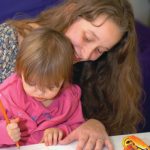Learning language and communication is a universal experience for children across cultures. Children develop communication and language skills in the context of their own culture and through meaningful relationships. Children spend the first year of life building the foundation for language, as they absorb what they see and hear through interactions with their caregivers and their environment.
During this time the brain is preprogrammed to learn language. The process of learning language involves nonverbal communication, processing and understanding sounds, and producing sounds.1 Even with the complexities of language, children’s abilities to communicate and acquire language are remarkable. Children learn language through their interpersonal, social interactions with their care- givers. Throughout the Guidelines, language development, communication, and literacy are referencing children’s development in their home, or primary, language, regardless of whether or not this language is that of the majority.
Language is part of communication. At first, children do not have language but they have the ability to communicate. Children use nonverbal and verbal communication to express their needs. They cry, grunt, and use body language. As they get a bit older, children use strategies such as sign language and gestures to communicate their needs before they are able to verbally express them. These communication strategies also support children who have language delays or hearing impairments. Children depend on attentive caregivers to understand and respond to these communication attempts in order to have their needs met.
Caregivers who respond thoughtfully and promptly provide a positive model for shared communication that all children can build upon. These early reciprocal interactions provide the model for back-and-forth patterns that are important for social communication. In infancy, children may respond to a caregiver’s voice by making eye contact, smiling, or cooing. Verbal children will engage in this same pattern, except they now use some words to communicate. These experiences provide the foundation for understanding the rules of turn-taking in conversations that children will use when communicating with others.
Children’s capacity to learn language in the first three years is remarkable.
They have the ability to learn more than one language at a time, and it is easier for children to learn an additional language than it is for adults. Research highlights that there is a critical period for acquiring more than one language; that critical period is the first five years of life.2 Children who learn different languages in the first five years are often viewed as native speakers because they acquire the languages by the same process as their first language, and are more likely to be fluent and accent-free.3
Children build their vocabulary and understanding through interactive experiences. They are not able to verbally express everything they are thinking, but they can understand more than they can say. They demonstrate their understanding by pointing, gesturing, or following simple directions. Older children understand more complex requests, such as two-step directions, with less prompting. Their ability to verbally communicate also improves. In the first year, children are practicing their expressive language through babbling, which takes on the sound of their home language. Around 12 months of age, first words emerge. Children’s first words are embedded in their cultural context and are usually names of meaningful objects and people. Eventually these singleword utterances transition to two-word combinations, and at 36 months, children are able to form short, simple sentences.
An important part of language and communication development is early literacy. Early literacy is the foundation for reading and writing. Children learn about early literacy through everyday experiences with literacy tools such as books, paper, and crayons. Reading, singing, and drawing are all meaningful activities that caregivers can engage in with young children to help support early literacy development. While children are not expected to read or write by 36 months, these positive, interactive experiences will serve as building blocks to develop literacy skills in the future.
Notes
- Lindfors, J.W. (1991). Language acquisition: Developmental sequence. In Children’s language and learning (2nd ed., pp. 111–157). Reprinted from: Erikson Institute WebCT.
- Lessow-Hurley, J. (1999). Foundations of Dual language Instruction, 3rd edition. Reading, MA: Longman.
- Lessow-Hurley, J. (1999). Foundations of Dual language Instruction, 3rd edition. Reading, MA: Longman.





